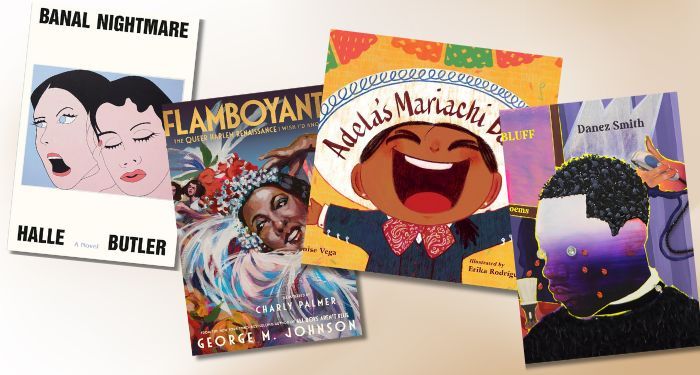★ A Million Quiet Revolutions
“You look stunning,” one narrator thinks about the other at the beginning of Robin Gow’s A Million Quiet Revolutions. The narrators are in love and beginning the process of transitioning their gender identities. After one narrator, a history buff, reads about two Revolutionary War soldiers named Aaron and Oliver who may have been transgender, the narrators adopt these names as their own, deciding that “We’ve been erased from / so much history. / Someone needs / to write us back in.”
When a terrible event at Aaron’s church causes his family to quickly move away from their small Pennsylvania town to New York City, the narrators face being separated for the first time since they were in first grade. During this time, Oliver tries on a chest binder and wonders whether he’ll have to redo his bat mitzvah, while Aaron’s new queer friends give him strength to come out fully to his Catholic Puerto Rican family. The pair reunite in New Jersey for a reenactment of the Battle of Monmouth, where their understandings of the past meld with their hopes for the present and future.
In Gow’s free verse poems, line breaks occur in unusual places and allow for contemplative pauses: “I stay on the low branches as / you climb higher.” Through Aaron’s and Oliver’s interactions with each other, their siblings and their parents, readers will find models for supporting trans family members. Gow also thoughtfully depicts Aaron and Oliver asking for and giving sexual consent.
Aaron and Oliver are frustrated that much of history ignores “what it was like to live as someone / other than a / white / Protestant / land-owning / man,” and as they discover that life needn’t follow gender binaries, their revelations ring with authenticity. Fans of classic YA literature will enjoy a subtle allusion to Laurie Halse Anderson’s 1999 novel, Speak, a book that was revolutionary in its time, too.
The Most Dazzling Girl in Berlin
The more we understand history, the more opportunities we have to form connections with one another. Such connections play a key role in Kip Wilson’s The Most Dazzling Girl in Berlin, which is set in the eponymous city just before Hitler’s rise to power.
Eighteen-year-old Hilde has just left her orphanage with a handful of Reichsmark coins and the painful memory of Gretchen, the girl who stole her heart. Looking for a job, she stumbles into Café Lila, a club where “all / kinds / of / love / are / possible,” and learns that they’re in need of a musical waitress. Hilde tries to summon up the courage to sing—which is especially difficult in front of the beautiful Rosa, whose aunt warmly welcomes Hilde to their Jewish home. Meanwhile, an important election is approaching and tensions are rising. Hitler’s National Socialists might win over desperate crowds through promises to end hunger and unemployment, but they’re also eager to find someone to blame for Germany’s problems, and they disapprove of what they consider “degenerate” establishments—places like Café Lila.
Alliteration (“languidly, leisurely, lovingly”), onomatopoeia (a clock counts “ticktack”) and words that travel across the page as Hilde moves around Café Lila (“tables / bar / floor / round and round”) add aural and visual interest. Hilde’s realization that she can decide what kind of person she wants to be strikes a quiet note of rightness. Although there’s no on-the-page sex, there’s plenty of acceptance, found family and sweet romance between two girls who know they’re “different from the others” in a time and place where being different means being in danger.
Both A Million Quiet Revolutions and The Most Dazzling Girl in Berlin use poetry to sidestep pronouns. The former makes dexterous use of “you” and “we,” while Ute, the “perfectly androgynous pianist” of the latter, is never referred to with pronouns at all. Both novels also use changes in layout to denote shifts in voice. Words are aligned with the left margin when Oliver and Hilde narrate, and with the right margin when Aaron, Rosa and Rosa’s aunt speak.
Readers in search of insight into the lives of queer teens throughout history—and inspiration for their own lives today—will find plenty of it in these books. As Oliver writes to Aaron about his history project on the gay rights movement during the late 1960s, “It makes me feel like / revolutions are still possible.”





